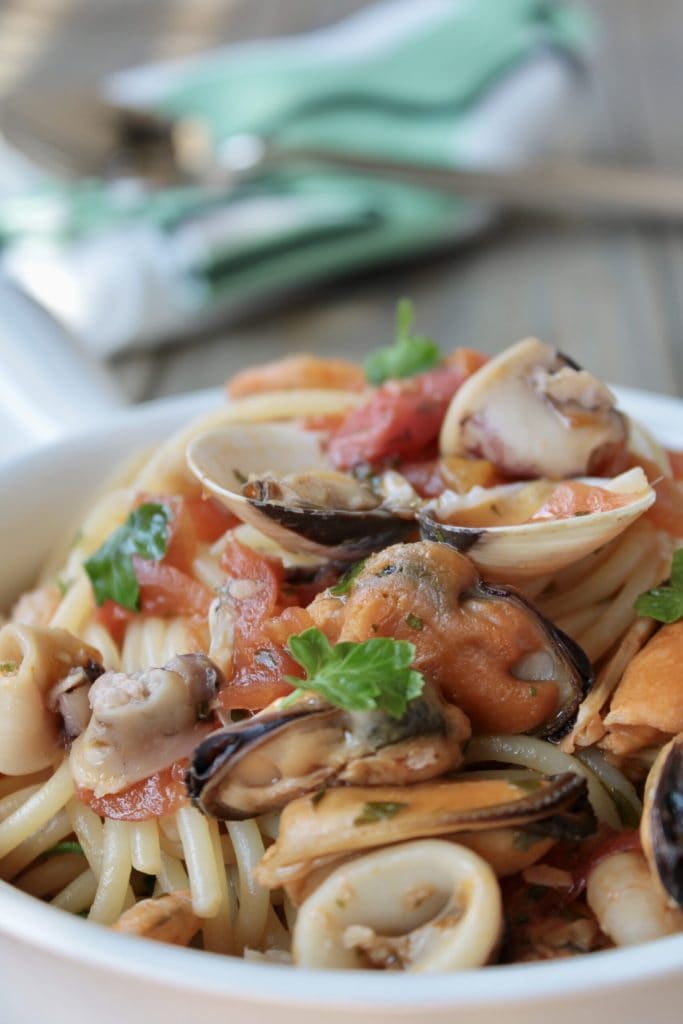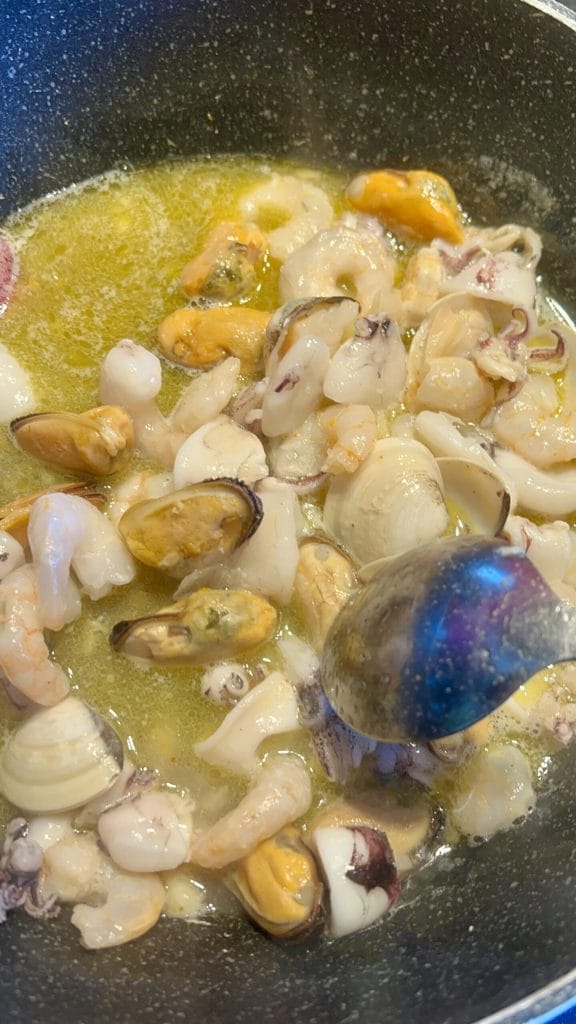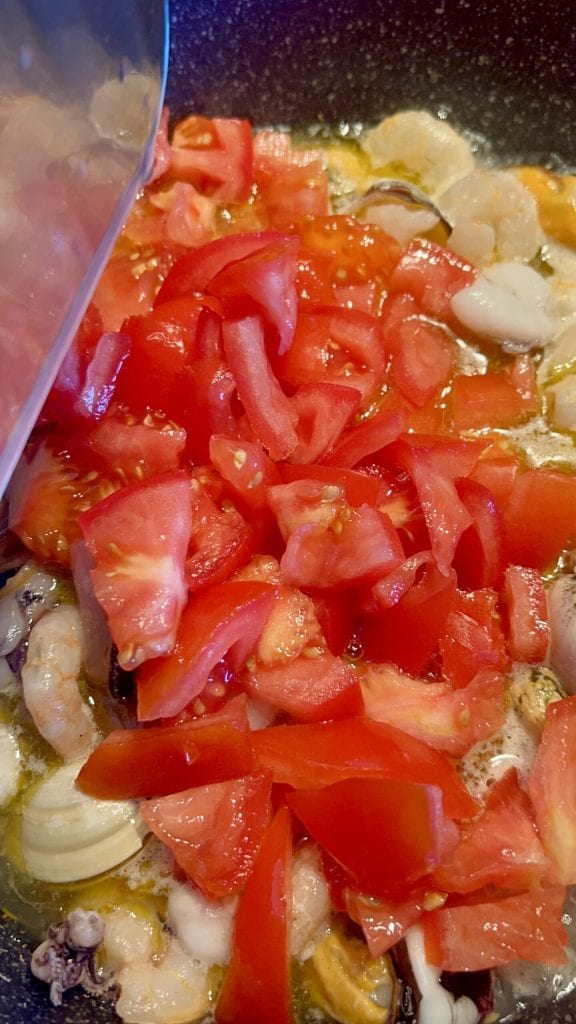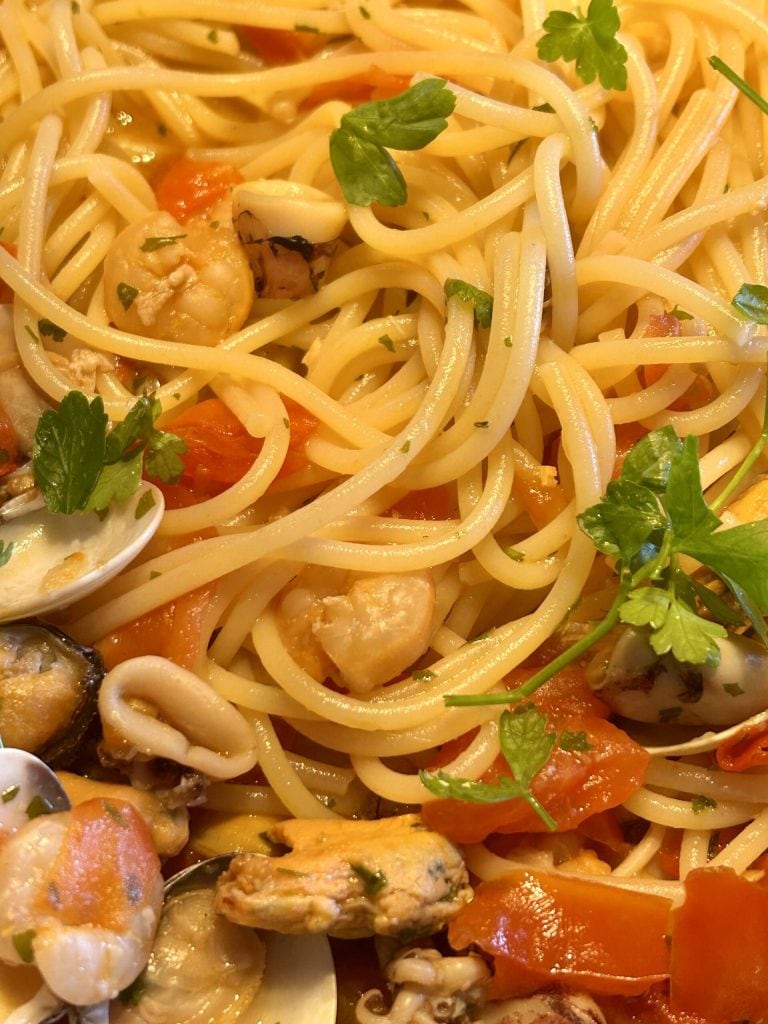Spaghetti with Frozen Fish: a tasty first course, easy to prepare and perfect even when fresh fish is not available.
Who says you have to go to the fish market for a good fish dish? Sometimes, just open the freezer to bring something really good to the table. I prepare it this way, with mixed frozen fish, a few simple ingredients, and the scent of the sea still arrives on the plate!
I like having it always available at home, convenient and ready to use, especially when I want to cook something healthy and nutritious without too many complications. Fish, even if frozen, remains a precious source of proteins and omega-3, and in this recipe, it gives its best!
A perfect first course for every day but also for a last-minute special dinner. I’ll explain right away how I prepare my fish spaghetti with frozen fish, step by step.

- Difficulty: Easy
- Cost: Economical
- Preparation time: 5 Minutes
- Portions: 2
- Cooking methods: Stove
- Cuisine: Italian
- Energy 439.64 (Kcal)
- Carbohydrates 35.15 (g) of which sugars 5.88 (g)
- Proteins 25.14 (g)
- Fat 12.85 (g) of which saturated 1.54 (g)of which unsaturated 0.55 (g)
- Fibers 3.79 (g)
- Sodium 1,618.97 (mg)
Indicative values for a portion of 350 g processed in an automated way starting from the nutritional information available on the CREA* and FoodData Central** databases. It is not food and / or nutritional advice.
* CREATES Food and Nutrition Research Center: https://www.crea.gov.it/alimenti-e-nutrizione https://www.alimentinutrizione.it ** U.S. Department of Agriculture, Agricultural Research Service. FoodData Central, 2019. https://fdc.nal.usda.gov
Ingredients
- 6 oz spaghetti
- 1 lb mixed frozen seafood
- 2 tomatoes, ripe, fresh (large)
- extra virgin olive oil
- 2 cloves garlic (medium or 1 large)
- salt
- chili pepper
- 1 shot cognac
- 2 fillets anchovies in oil
- parsley
Tools
- 1 Pan
- 1 Ladle
Preparation
Put a pot of plenty of salted water on the stove: you’ll need it to cook the spaghetti as soon as the sauce is ready. Meanwhile, in a high-sided pan – so you can also use it to toss the pasta – pour a drizzle of extra virgin olive oil, add a chopped garlic clove, and the chili pepper. Let it sauté over medium heat until the garlic becomes golden. At this point, add the still frozen mixed seafood, cover with a lid, and let it cook over high heat for about 5 minutes: the fish will begin to thaw and release its natural water, creating a tasty base for the sauce.

Wash the red tomatoes well, chop them into pieces, and add them directly to the pan with the cooking fish. Season with salt to taste and continue cooking for another minute, leaving the lid slightly lifted. This way the steam can escape and the sauce will start to thicken, becoming more concentrated and tasty. When the water in the pot comes to a boil, add the spaghetti and cook them for the time indicated on the package, keeping them al dente. The sauce is almost ready, and the pasta will finish absorbing flavors directly in the pan, together with the fish dressing.

About 10-15 minutes after starting the sauce cooking, it’s time to add an extra touch of flavor: add one or two anchovy fillets, according to your taste, and stir until they melt in the hot bottom. Add a shot of cognac, let the alcohol evaporate for a few seconds, then turn off the heat. The sauce should remain slightly liquid, so it will be perfect for coating the pasta. As soon as you’ve turned off the heat under the sauce, it’s the perfect time to add fresh parsley. Wash it, tear it with your hands, and add it to the pan.

A few seconds before the spaghetti is completely cooked, put the pan with the sauce back on the stove over high heat: it must be very hot at the moment of tossing. With the help of the spaghetti ladle (and not the colander), drain them directly from the pot to the pan, a little at a time. This way you’ll bring with you the right amount of cooking water, useful to create a natural cream that will perfectly bind pasta and sauce.

If you’ve accidentally added too much water, don’t panic: raise the heat and let the spaghetti toss for a few more minutes, so the excess liquid will evaporate. That’s why it’s important to always cook them al dente: you’ll have room to adjust the consistency without risking them overcooking.
Once the pasta is well coated and the sauce has wrapped around each spaghetti, plate up, add a final touch of fresh parsley, and bring to the table. Enjoy your meal!
NOTES
This recipe is simple but versatile and can be easily personalized according to tastes.
I always add a bit of chili pepper to give it character, but if you don’t like it, you can replace it with a grind of black pepper. For a more decisive flavor, I also add one or two anchovy fillets in oil: they melt in the sauce and enrich it. If you wish, you can also add some capers or a bit of drained tuna, or leave the sauce simple, just with the fish and tomatoes.
A tip: drain the spaghetti with the slotted spoon, not the colander. This way, you’ll better control the cooking water and achieve a creamier, well-bound dish.
If you liked the recipe or have questions, don’t hesitate to comment here or on social media Facebook, Pinterest, Instagram and X.
FAQ (Questions and Answers)
Can I use fresh fish instead of frozen?
Yes, definitely! If you have fresh fish available, the flavor will be even more intense. However, remember to adjust the cooking times: fresh fish cooks faster, so add it after flavoring garlic and oil and cook it only a few minutes to avoid it becoming rubbery.

